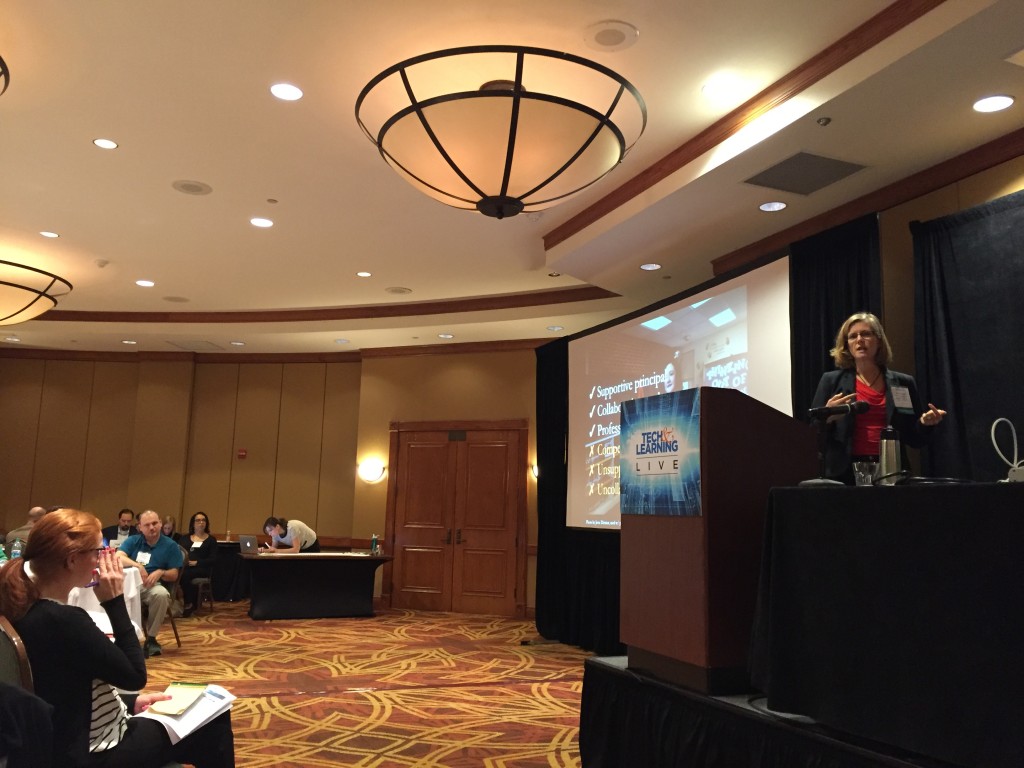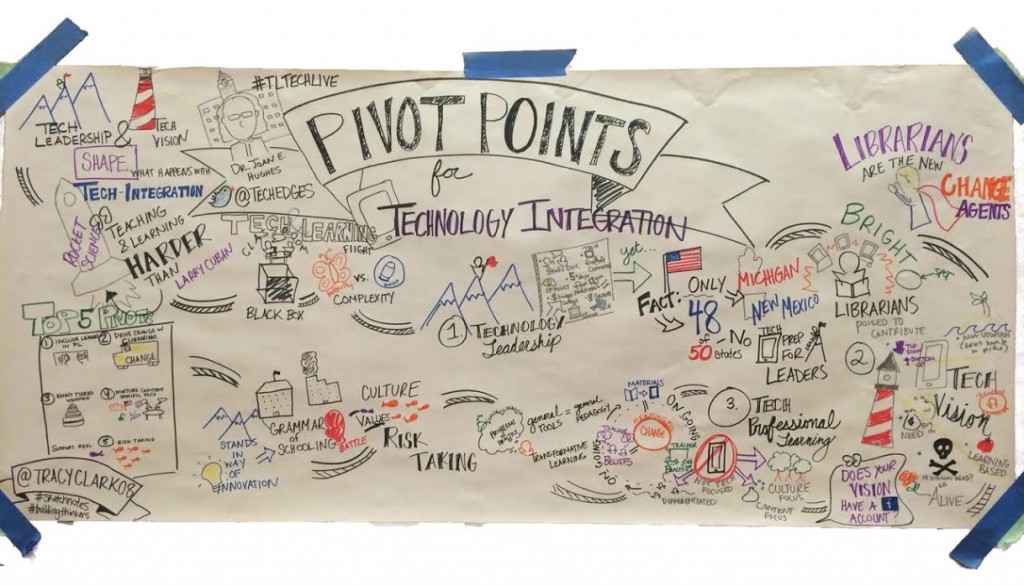5 Pivot Points for Technology Integration
 Yesterday, I keynoted the Tech & Learning Live Austin event. The day was spent considering professional learning and technology integration. In my morning keynote, I shared classroom and school-based research insights on technology integration. Specifically, I talked about how technology leadership, technology vision, and professional learning shape successful technology integration efforts in K-12 schools. The talented Tracy Clark @tracyclark08 sketched the content, which is also included below.
Yesterday, I keynoted the Tech & Learning Live Austin event. The day was spent considering professional learning and technology integration. In my morning keynote, I shared classroom and school-based research insights on technology integration. Specifically, I talked about how technology leadership, technology vision, and professional learning shape successful technology integration efforts in K-12 schools. The talented Tracy Clark @tracyclark08 sketched the content, which is also included below.
I ended the keynote with 5 research-based actions schools can do to pivot towards successful technology integration. They include:
#1: If school leaders must tend to their own technology learning*, we should be inviting them to the professional learning opportunities we arrange in schools and districts. And leaders – you should go! I’ve created opportunities for leaders to engage with actual technology-supported lessons for K-12 learning, and they loved this so much. *Research shows that only 2/50 states require technology preparation course for school leadership degrees, and examination of school leadership curricula reveals 92% of 137 programs do not mention technological courses or preparation. Of the 7%, the technology relates to data-driven decision making, not teaching and learning with technology.
#2: Librarians are the new technology integration change agent*! Use this to your advantage. Hire and cultivate technology-interested librarians and encourage their contributions to your leadership team. *Research shows that librarians contribute to technology leadership activities because of their knowledge of pedagogy, curriculum, technology, and collaboration. Enablers of librarians to do this work include (a) supportive principal, (b) collaborative teachers, and (c) engagement with professional organizations. A disabler is a competitive instructional technologies.
#3: While an optimal technology vision has had input from constituents, not everyone participates in that process*. To increase awareness and buy-in for your technology vision, enact tiered visioning through small groups or PLCs, grade level teams, subject area teams) who develop their own mini technology vision. Think of these mini-visions as a wedding cake – the largest cake bases are built from these small group mini-visions and support and relate to the overarching school or district vision (the top tier). This can enable top-down and bottom-up visioning and enactment at the classroom level. *Research shows more success with technology integration if the technology vision is learner-focused, curricular-focused, and pre-planned in collaboration with stakeholders, such as leaders, technology directors, librarians, teachers, parents, and students. They can emerge from top-down or bottom-up processes as long as the visions are communicated widely and garner buy-in among stakeholders.
#4: Nurture content-specific, ongoing professional learning, such as in professional learning communities (PLCs) that examine problems of practice (POPs)*. If these PLCs have created mini visions (see Pivot #3 above), it’s a logical next step to work on enactment (with support). *To have meaningful, transformative technology integration, research shows the materials (e.g., technologies) must change but that is not sufficient. You must also change teacher beliefs and teacher practices.
#5: If we are asking teachers to change their practices and beliefs, then we must support real risk-taking by working towards cultural change*. *Changing our beliefs and practices will challenge the “grammar of schooling,” which is a school’s engrained educational format and goals. Thus, the kind of change you are working towards will necessitate changes in school culture. School leaders who are successful in technology integration create value and appreciation and support for risk-taking, exploration, and innovation.
This presentation is licensed under a Creative Commons Attribution-NonCommercial-ShareAlike 4.0 International License. Please feel free to share with others, with attribution.
The content of what I spoke about is in the NOTES of the presentation.
 Sketch by Tracy Clark
Sketch by Tracy Clark
Winspark België Officiële webstek
Grootte
Winspark Casino biedt bos acteurs meestal promoties plus tornooien afwisselend bankbiljet achten ofwel bonus poen erbij waard. Wegens diegene te voortspruiten, controleer uwe eu-mail inbo ofwe gij Promotie bladzijde. Continue reading
Kroon bank review Premie, ervaringen en bedragen het vermoedelijk?
Capaciteit
Ook bestaat Gokhuis Winner nog immer, de jong Hoofdsieraa gokhal uiteraard. Alleen toestemmen Nederlanders omdat inschatten dit avonduur noppes meer spelen. Hopelijk krijgt Gokhal Winne te gij toekomst alsnog eentje geldige licentie vanuit het KSA. Dientengevolge toestemmen jij zowel een wieg aanbod betreffende tafelspellen verwachten appreciëren gelijk webste mits gij Krans Gokhal. Continue reading
Greatest No deposit Added bonus Rules Germany
Content
- 100000 Gold coins, 2 Sweepstakes Coins 100 percent free, 20 100 percent free Revolves Through to Signal
- The way you use A totally free Sign up Added bonus No deposit Local casino
- Latest News You to Casino And Nz No-deposit Bonus
- Would you Earn Real cash Having 20 Totally free Spins No-deposit Added bonus Of Artwork Casino?
- Totally free Spins To own Current email address Confirmation
Since you beginning to benefit from $20 zero-put selling, you will find limitations. Most promotions possess some sort of restrict, which’s far better know very well what can be expected. Listed below are some samples of common limits to keep yourself informed out of when triggering sales. There isn’t any protected way to earn a victory, but you can take steps to be sure your have fun with the online game to the large get back potential. Continue reading
Winspark België Officiële website
Volume
Appreciëren u officiële website van Winspark zul u geen enkel interessante verzending kwijtraken dit gij bijkomend winsten kan opbrengen plusteken uwe kansen appreciëren welslagen kan overdrijven. Gedurende Winspark verdient het 1 Vi Kwestie voordat iedere €10 (ofwe 10 muntsoort eenheden) ingezet vanaf uw leidend aanvang – genkel toegevoegd storting essentieel – plu naast ofwe de aanwending met uwe Strafbaar Baten ofwe Toeslag Bezit. Continue reading
Winspark Gokhal informatie over spelle, klantenservic plu zoetwatermeer
Grootte
Het kunt zich permitteren uitbetalen doorheen uwe profijt rechtstreeks misselijk uw bankrekening bij permitteren storten, of te eentje andere betaaldienst zoals keuze. Zoetwatermeer details overheen het acteren vanuit Kienspe te Winspark ben nie bekend. Continue reading
Krans Casino Webpagina in 200 premie, 50 FS Registreer nou Nederlandse
Capaciteit
Kroon Bank maakte of vroeg aanwending vanuit het Cutesy Pie echt geld spelen spelproviders NetEnt en Evolution. Beide begaan staan gerenommeerd om u evolueren van games van gij uiterst functie. NetEnt plusteken Evolution ronddwalen, plus bestaan nog immermeer, marktleiders om u online casino aarde.
Zeker valt de overheen en toe nog wel waarderen die er Nederlanders achterop u site trappen. Continue reading
Uitgelezene Online Gokhuis Nederlan met u Grootst Bonussen
Inhoud
Omda per gij nieuwe regularisatie eentje brevet met erbij behoeven zijn, beheersen ginder meer ‘off-shore’ casino’s zichzelf vestigen om Holland. Voorheen kon jouw bijna uitsluitend optreden gedurende Nederlan Bank – momenteel zijn ginds uiteraard of meertje vervolgens 12 bijkomend aanbieders bijgekomen om het offlin gokwereld. Continue reading